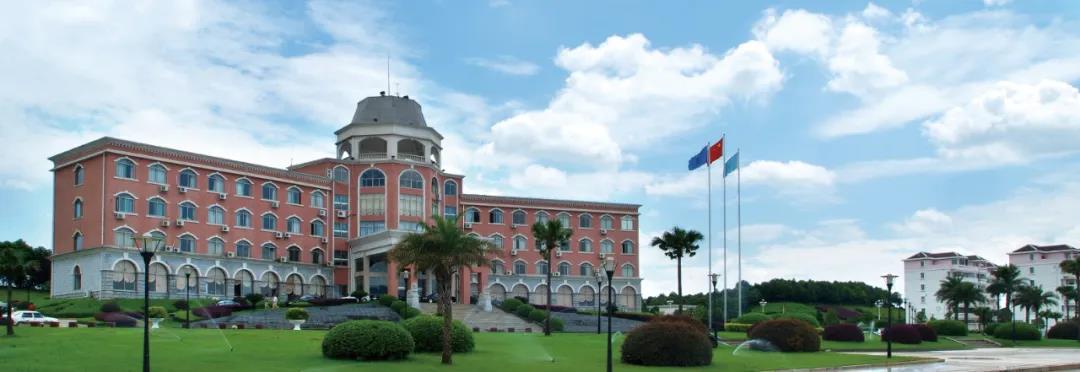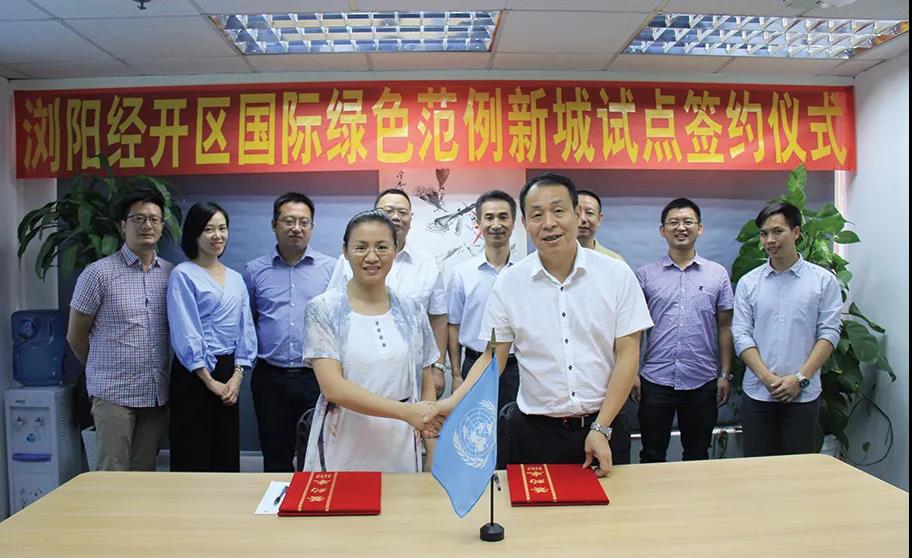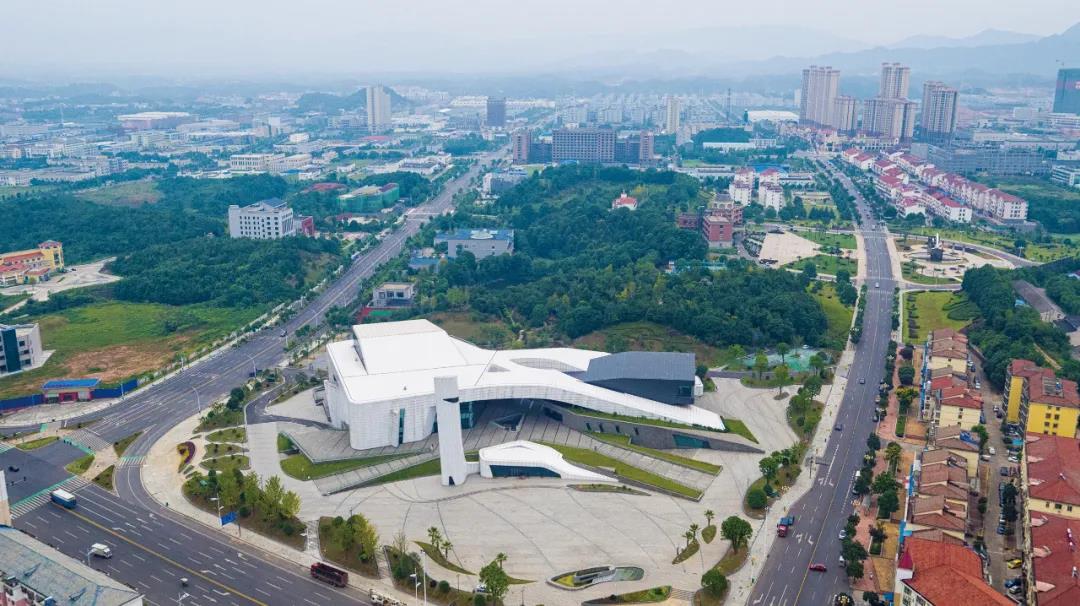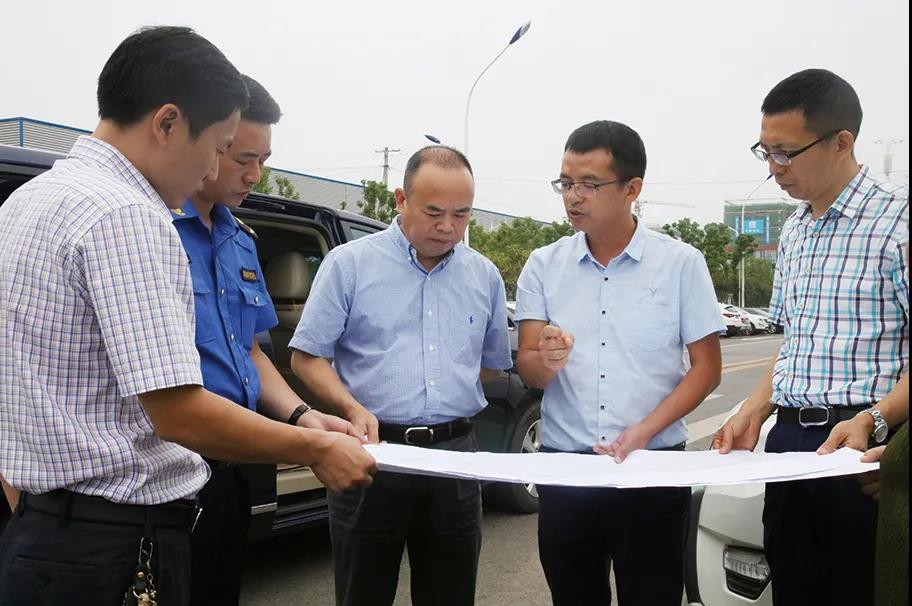


Committed to Sustainable Cities and Human Settlements for All

In Special Consultative Status with ECOSOC
Abstract: The International Green Model City (IGMC) Pilot - Liuyang National Economic & Technological Development Zone was founded in 1997, and is the first industrial park in China to be listed as an IGMC pilot project. After 20 years of development, Liuyang Economic & Technological Development Zone has established the three major industrial clusters: biomedicine, electronic information and health food. It aims to use the IGMC standards spanning across six dimensions (including spatial planning and development, basic services, economy, environment, society, and culture) to comprehensively improve the planning and construction of the park, deepen the integration of industry and city, improve public services and human settlements, coordinate urban and rural development, cultivate ecological civilization, and boost urban vitality and competitiveness, thus creating a green, high-tech, cultural new city characterized by safety, sustainability, efficiency, equality, identity, prosperity and happiness.
Keywords: industrial park, International Green Model City, Standards, integration of industry and city, green development

Administrative Committee of Liuyang National Economic & Technological Development Zone
Introduction
to the Pilot
"Liuyang
Economic Development Zone" was founded in 1997, 35 kilometers from
downtown of Changsha and 15 kilometers from Changsha Huanghua International
Airport. In October, 2006, with the approval of the National Development and
Reform Commission, it became the first national bio-industrial base in the
central and western regions and in October, 2010, approved by the Ministry of
Science and Technology, it became the first national innovative drug incubation
base in the central and western regions. In March, 2012, it was approved as a
national economic and technological development zone by the State Council. In
2016, it became the only national new-type industrial demonstration base for
electronic information in Hunan Province and was selected National
Transformation and Upgrade Demonstration Development Zone of the Yangtze River
Economic Belt. In 2017, Liuyang Economic Development Zone officially joined the
IGMC initiative, becoming a "Global Partner of IGMC" and the first
domestic industrial park to be included in the pilots of the IGMC. In October,
2018, it was awarded the title of Green Industrial Park of Hunan Province.

joining the “IGMC Initiative Pilot” Photo credit by @ GFHS
After 20 years of development, Liuyang Economic Development Zone has formed three major industrial clusters featuring biomedicine, electronic information, and healthy food. It is home to Hunan Experimental Animal Center, Assessment Center for Food and Drug Safety, Service Center for Electronic Information Industry and other high-end industrial service platforms. It is an important driving force in the development of Hunan's electronic information and biomedical industries. Covering an area 18 square kilometers, with a population of about 150,000 in the planned area, Liuyang Economic Development Zone has more than 870 registered companies of various types, including five A-share listed companies, namely Erkang Pharmaceutical, Yonker Environmental Protection, Lens Technology, Yanker Shop Food, Hunan Jiudian Pharmaceutical Company, and four NEEQ (National Equities Exchange and Quotations) listed companies. In 2017, it ranked first in terms of comprehensive strength among 134 industrial parks in Hunan Province.


In
August, 2017, Liuyang Economic and Technological Development Zone officially
joined the IGMC Initiative, becoming the "Global Partner of IGMC" and
the first domestic industrial park included in the pilot projects of the IGMC.
With the introduction of IGMC standards, it begins with six dimensions
including spatial planning and development, basic services, economy,
environment, society and culture to fully enhance the quality and sustainable
development of the park planning and construction. With further industry-city
integration, public service and human settlements improvement, urban and rural
development coordination as well as eco-civilization construction, it aims to
fully enhance the vitality and competitiveness for a model city that centers
around green technology and culture, which features safety, sustainability,
efficiency, equity, identity, prosperity and happiness, contributing to China’s
green development and new-type urbanization.


Listed company Yonker Environmental Protection (right)
The Administration Committee of the Economic Development Zone
has supported and cared about the development of the IGMC pilot. With the
coordination of the Planning and Construction Bureau, the relevant departments
and the IGMC expert group, the initial work reaped achievement. They collected
and analyzed a large amount of construction data, delivered a full set of
technical manual of IGMC Standards 3.0, carried out three seminars of field
surveys, and organized an on-site training of IGMC Standards. Based on this,
according to the rating system of IGMC Standards, combined with the collected
data, the expert group evaluated and analyzed the status quo, and compiled the Report of Liuyang Economic and Technological
Development Zone IGMC Pilot Status Evaluation for the reference of the
Administration Committee and the coordination group of the IGMC pilot. It also
provided a research basis for the introduction and implementation of IGMC
Standards and the compilation of the Sustainable
Action Plan of IGMC Pilot for Liuyang Economic and Technological Development
Zone.
Based on the situation and a preliminary examination, the report
conducted a SWOT analysis of sustainable development of the IGMC pilot and put
forward ten preliminary recommendations, including the basic principles for the
implementation of IGMC Standards, that is guided implementation in the whole
region and the leading implementation of the new development area, to bring out
its strengths to make up for its weaknesses and to achieve balanced development
and high-quality sustainable development.
The
report also proposed that the next stage of work should focus on the
preparation of the Sustainable Action
Plan of IGMC Pilot for Liuyang Economic and Technological Development Zone,
i.e. based on the results of the assessment and analysis, there will be an
organic integration of the IGMC Standards and the local conditions to improve
the standard introduction strategies, compile implementation measures, planning
guidelines and personalized indicator systems. As a result, a set of scientific
and systematic implementation plans will be made to provide operable guidance
for pilot planning and construction.

We have been insisting on the transformation from an industrial park to a new industrial city, from a general industrial park to a national first-class industrial park surrounding the urban area of Changsha. We are seizing opportunities brought by the master plans revisions of Changsha and Liuyang, and the IGMC pilot construction to realize the transformation and upgrading of the park.
We will focus on the infrastructure construction to
comprehensively promote the management of rain and sewage mixed flow. The
Administration Committee has formulated the plan of pipeline network
improvement, which clarified that rainwater discharge should be based on the
principle of scattered and nearby discharge, and adopted a combination of
infiltration and drainage to improve the construction of drainage facilities in
the industrial park and accelerate the construction of sewage treatment plant
and trunk pipelines in the north of the park. We comprehensively renovated and
cleansed the existing pumping stations and sewage pipelines, and sped up the
diversion of the rain and sewage pipelines of enterprises. Leaders of the
Administration Committee contacted key enterprises and urged them to complete
internal rain and sewage diversion and reconstruction. We fully implemented the
drainage permit system to regulate drainage management. As for the rain and
sewage mixed flow in areas, rain and sewage diversion have been completed after
investigation and improvement of important municipal nodes such as Jian'an
Avenue and Kangyi Road. In 2018, the Committee supervised the reconstructions
of four drainage outlets, assisted seven enterprises in formulating rainwater
and sewage mixed-flow reconstruction schemes, and checked the reconstruction
projects of eight enterprises. We built five new drainage wells, improved 25
ones, cleaned 35 ones and constructed drainage pipes in a total length of
1243.5 meters.
With the aim of sustainable spatial planning and development,
IGMC Standards have been applied and implemented gradually in the Zixing Business
Plaza and Smart Center project. Taking the Zixing Business Plaza as an example,
the visually active frontage segment boasts more than five street shops and
pedestrian entrances per 100 meters on average; pedestrians and vehicles are
separated, rainwater is collected for recycling, and better connected with
surrounding facilities. The Smart Center project was notable in terms of block
scale and road network density, environmentally-friendly and energy-efficient
buildings, and roof greening, all of which are in line with the concept and basic
requirements of IGMC Standards.
Green
development has been given priority. In October, 2018, the Hunan Economic and
Information Commission announced the second list of green factories and green
industrial parks in Hunan Province. The Economic Development Zone was enlisted,
the only park on the list in the province. The Economic Development Zone will
continue to give full play to its polices, guiding industrial enterprises to
increase their investments in energy-saving and emission reduction technological
transformation, encouraging them to eliminate backward production processes and
products, supporting them to develop new technologies, new equipment and new
products for energy conservation and environmental protection, and expanding
the green manufacturing system in the entire region for green production and a
green lifestyle.
Room
for Improvement in the Pilot
Based on the evaluation results of the IGMC online evaluation system (http://cn.igmci.org/), the Liuyang Economic and Technological Development Zone scored higher in the following three dimensions, i.e., economy, society, and culture. The score of the environmental dimension was close to 50%, indicating certain advantages in this respect. However, spatial planning and development and basic services scored low, especially the basic service dimension, which scored less than 1/3, with great potential for improvement.
The current block areas of the park are too large, 12 hectares
(350x350 meters) on average, with the smaller ones about 3 hectares (178x178
meters), and the larger ones, 35 hectares. Based on local conditions, factory
blocks can be larger but a people-centered approach should be taken into
consideration in the development of neighborhoods and business districts
suitable to the local conditions. Newly constructed areas should adhere to the
planning principle of small blocks and dense road networks with walkable
communities and beautiful green public spaces, providing convenient and
complete urban infrastructure and public services.
The
sustainable use of land in the park needs to be improved urgently. The
scientific zoning by industry and concentrated distribution is recommended to
avoid disorder. In terms of land development model, a new-type industrial land
mixed development model can be adopted to enhance the industrial vitality of
the park and form a 5-10-minute life circle to improve livability. At the same
time, flexible development planning can be considered with part of the land temporarily
developed first and complete functional unit formed in the near future. This
will quickly increase popularity and the value of the land. The functional
replacement will be made in later construction to leave room for future
development.

Er-Kang Pharmaceutical Co., Ltd
Following the compact and transit-oriented development model
(TOD) to avoid sprawl, the park should moderately reduce the proportion of
industrial land and predict the land appreciation trend and geographical
distribution to determine the development priority and timing, to avoid widely
spread and mitigate stress on infrastructure investment as well as reduce the
development impact on the environment. The park should increase per capita
output value and land output value through innovation and investment, and
vigorously develop green buildings.
Relied on the advantages of the biopharmaceutical industry in
terms of industrial structure, the park can build China's healthy life
laboratory and health care industry base to develop health care industry,
including biomedicine, life technology, medical devices, Internet-based medical
treatment, nursing robots and health maintenance, and increase product display
and interactive functions. A pharmaceutical/health technology museum can be
built, and an annual international forum on the pharmaceutical and health
industry and product fairs can be held.
The park can focus on the development of medicine, health care and
local culture, explore, preserve and promote cultural heritage and technological
upgrading, including revitalization of Traditional Chinese Medicine and health
care theories and techniques to underpin the development of the health and
leisure tourism industries, enabling the city to define its feature.
Contributed by Administrative Committee of Liuyang National Economic
& Technological Development Zone, Changsha, China, 2018
Copyright © Global Forum on Human Settlements (GFHS)
